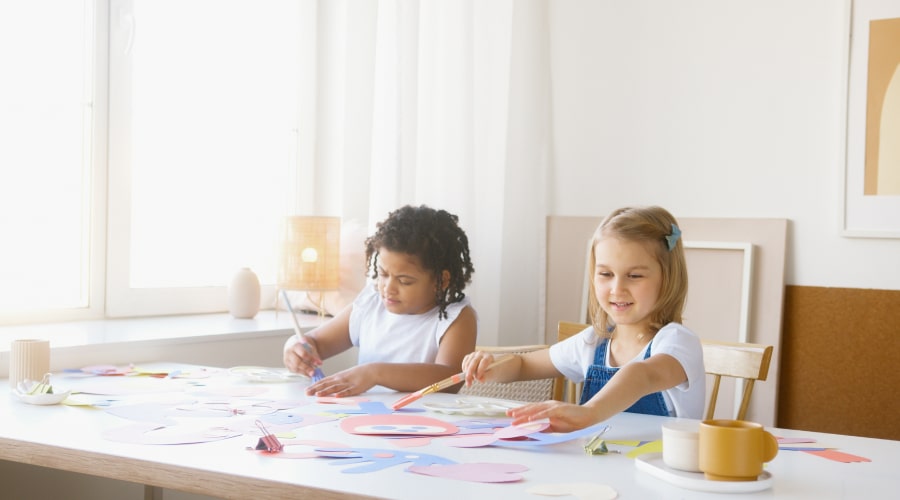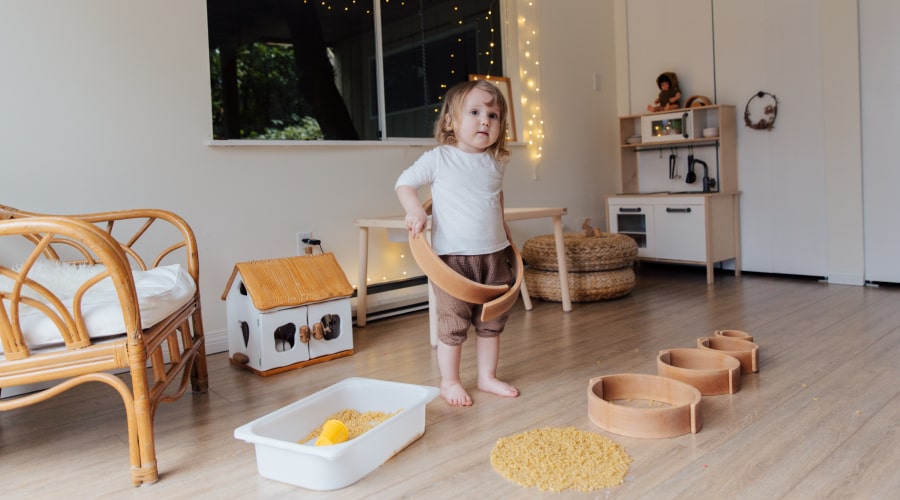settings
children
With Famly since
I remember playing in my friend Lynn’s attic as a child. It was a magic place where the angles of the sloped roof and the golden light of the dormer windows cast a haze of warmth around our make-believe world.
Beyond the eyes of adults, we brought to life mysteries and adventures with our dolls and animals. We created forts, dramatic plays, and games. During our all-encompassing focus, time stood still. We were free from worry and filled with empowering joy.
As you remember your own childhood, what was your favorite play activity? How did play shape your sense of self and way of being? Did you recognize early on that you were good at something special? Thinking about our own experiences can help us see play experiences through the eyes of children.
Childhood play is where children become lost in the flow of creative wanderings and wonderings. They experience a safe and protected space with uninterrupted time and freedom to imagine, dream, create, test their skills, and discover new interests.
And as adults and caregivers, we need to understand when to join children’s play, and when to let them explore in their own world.

Why we need guided play
Guided play is a shared experience between adults and children where adults provide scaffolding (preparation of relevant and engaging materials, modeling of new skills, and purposeful conversation) to boost language, development, and learning.
While independent and unstructured play is the anchor for early childhood development and learning, children can benefit from the sensitive and caring support of adults.
During guided play, families and teachers may gently intervene in activities that young children find engaging and motivating. Children direct their choices, experiment with new materials, design creative roles and activities, and test ideas, yet adults play a special and important role.
During our earliest play experiences, joint attention with an attuned adult fosters language, self-awareness, and a lasting sense of belonging and connectedness. Through our first play interactions, we learn turn-taking, a skill that supports positive learning and relationships throughout life. Playful interactions offer a rich foundation for development that cannot be recreated or replaced by any other life experience.
Our world has changed, but the need for play at home and in early childhood settings is more important than ever. Children are more reliant on screens now, which comes with risks to healthy development. It’s up to adults to guide them towards more productive play.
How guided play sets children up for life
Childhood play builds competencies that children use throughout their lives. Play helps them develop body balance, fine motor dexterity, proprioception (knowing where we are in space), hand/eye coordination, and physical strength.
Play experiences teach children problem-solving and creativity, divergent thinking and insight, persistence towards goals, curiosity, self-discovery, and creativity. During play, children practice emotion competence and social skills, use greater self-regulation, and feel reduced stress. Dramatic and interactive play foster critical skills for academic learning, such as symbolic thinking, meaningful connections to prior knowledge, pride in cultural contexts, and strong language, cognitive, and social skills.
Guided play has benefits for families and teachers, as well. During play, adults have the opportunity to become keen observers:
- What do you notice motivates children?
- What skills are just emerging that need support?
- What special skills and talents require nurturing?
- What areas of development need special attention and care to be strengthened and thrive?
During play, adults can hear children say the most insightful things about themselves and others. As children ask profound questions and try to make sense of their world, adults learn to become attuned and really listen. Observing and participating in play offers the opportunity for adults to know children more deeply and to respond more effectively to their needs and strengths.

The big ideas
Why children need to play
Play is not aimless! It is not simply a collection of materials prepared by adults. It is not free experimentation at the whim of children’s own choices. Play is purposeful! It builds on the ideas and imaginations of children. It emerges from their interests and imaginings.
Play provides opportunities for children to explore and understand the world and to satisfy their curiosity about how things work. What makes things float? How do blocks balance? What makes the ball go faster? Why does wind make a musical sound when it blows through a tube? What strategies work best to solve a problem? Play-based learning invites children to integrate their previous understandings with new and interesting discoveries.
During play, children develop compassionate friendships and the ability to connect meaningfully with and contribute to the happiness and ideas of others. They develop confidence in expressing creativity, using divergent thinking, and solving problems. When children are at play, they are developing skills for a collaborative life, filled with self-satisfying and shared-nourishments where individual talents and skills can thrive.
How can you do guided play?
So how do you support children’s play? When you join children in play, here are some tips and practices you can use to help enhance their play.
- Make the most of spaces and materials. Clean and organize, sort, and gather natural collections and interesting objects.
- Put together related props for thematic play, so that children can carry out meaningful scenarios or games.
- Introduce new vocabulary by asking questions and modeling new ways of playing with materials.
- Support children’s interests by providing informational picture books and helping children find answer questions that are meaningful and relevant to them.
- Encourage daily outdoor experiences with freedom to run, interact with nature, and enjoy active physical play.
- Foster engagement with the creative arts, including play with musical instruments (home-made sound-makers are perfect), songs, chants, open-ended art projects (where children choose materials and express their ideas in ways they choose), and documentation of personal experiences through poems, stories, and dramatic play.
- Revitalize daily reading and storytelling. Books offer rich stories and characters to inspire imaginative play.
- Sit in the children’s spaces. What is missing? What is inviting and challenging?
- Evaluate available play materials. What would engage you, if you were a child in this space and with this time? What do you notice that engages children?
- What can you use from materials you already have (boxes, empty cartons, papers, magazines, and natural materials) that can inspire innovative construction play?

When are we helping play, and when are we getting in the way?
During guided play, you may step in actively to help organize games or assist children with finding needed materials. Other times, you’ll step back and observe carefully. Sometimes, you will be a gentle guide during play, introducing materials without interrupting the flow of children’s thoughts or concentration.
Learning how to guide play requires practice and sensitivity, so that you can intervene without obstructing, taking over, or controlling children’s actions. Instead, you want to be an empathetic scaffolder: The one who helps children develop confidence in their own decisions.
Children need time to try things out, experiment, and learn from making mistakes. This must happen in a safe way, without criticism or fear. The goal is to empower children to have confidence and take pride in their growing sense of self and in their relationships with others. Your job is to find the balance of supporting and observing in a way that helps them achieve their play goals.
Sometimes, you will need to add more challenging options for materials or provide information books to help children discover more. The key is developing awareness of children’s skills, strengths, and interests and looking intentionally for ways to strengthen their language, learning, and creative engagement.
Reflecting on your own approach to guided play
Early positive play experiences strengthen children’s perceptions of themselves as capable and competent thinkers, creative innovators, and confident learners. During play, children develop caring friendships with peers and trusting relationships with adults.
These shared collaborations will become a secure and treasured foundation for the healthy and satisfying choices children will make throughout their lives.
Here are some reflection questions that can help you evaluate your own approach to guided play:
- When you observe children at play, what emerging and new skills are strengthened?
- When you prepare and evaluate a play area, what kind of modeling and support will be needed to help children engage and sustain play?
- How can you foster advanced language and concept learning during play? Are there descriptive words, additional information, questions, and conversations that will engage children’s thinking and extend their ideas?
- Do artifacts, materials, and stories represent the cultures and languages of the families and neighborhood so that play activities are meaningful and relevant?
- Are there multiple levels of challenge present so that children can engage with curiosity and interest?
- During play, document children’s activities by taking photos and videos of their creative work, play scenarios, and activities. Ask them to write about or tell you about their play. What new insights and understandings do you discover about each child? How can observation and documentation help you better support each child’s playful learning?
Marie Masterson, PhD, is the Director of Quality Assessment at the McCormick Center for Early Childhood Leadership at National Louis University. She is a licensed early childhood teacher, national speaker, child behavior expert, and author of multiple books and articles that address high-quality teaching, behavior guidance, parenting, early care and education, and early childhood leadership. Marie’s newest book, Transforming Teaching: Creating Lesson Plans for Child-Centered Learning, was released in April 2021 through the National Association for the Education of Young Children. Please contact Marie at: www.mariemasterson.com
Try learning journals for free
Add observations, and build digital learning journals to share with families instantly. All with your completely free 14-day trial.
Get started









